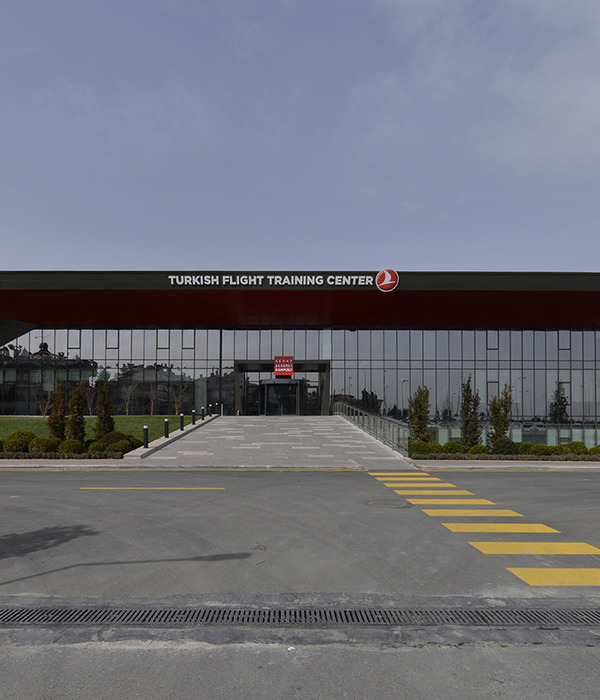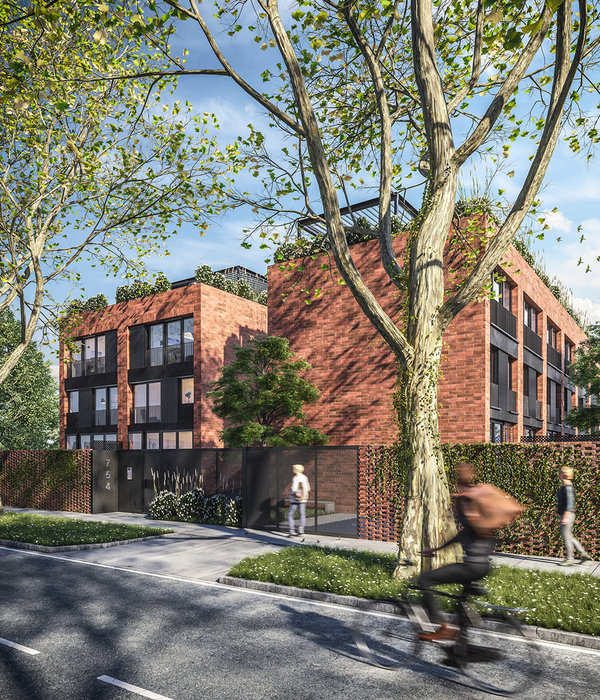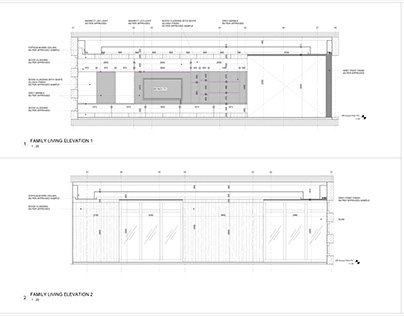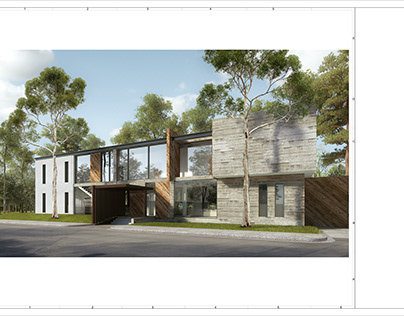H to V住宅位于伊朗伊斯法罕市某高密度的住宅街区中。项目的设计旨在探讨如何将传统的伊斯法罕住宅转化为城市街区内的现代住宅,在梳理空间关系的同时,传承传统住宅中的室内流线逻辑与空间本质。作为世界遗产城市之一,伊斯法罕市内保存了大量最具代表性的伊朗建筑以及城市空间纪念碑。这座城市的人们已经与多元文化和宗教多元共存了好几个世纪,在众多文化和宗教的影响下,人们也逐渐形成了一种极为复杂却具体的行为模式。
▼项目概览,overall of the project
The H to V House is located in a high-density urban block in the city of Isfahan-Iran. The project’s design corresponds to how traditional spatial relationships in a conventional Isfahan House can be transformed into a modern house within an urban block, whilst maintaining the same traditional circulation concerns and essence of space. Isfahan is considered as one of world heritage cities, which houses some of the best Iranian architectural and urban space monuments. The people of this city have coexisted with multi-cultural and religious diversities for many centuries, and as a result of numerous cultural and religious influences they have built a very complex and specific behavioral pattern.
▼项目与周边城市环境
▼顶视图,top view
本项目为建筑师创造了一个专注于探索伊斯法哈尼家庭行为、社会关系,以及传统住宅形式的机会。深入的研究为设计打下了坚实的基础,造就了最适合该城市环境的住宅,并保持了能反映出当地文化的关键性室内交通流线。项目坐落在一个密集的中产阶级家庭社区,场地面积约为300平方米。场地的三面均毗邻其他住宅,且市政当局规定最大土地占用率为60%,因此,建筑师将住宅体量布置在地块的北部,材料和颜色的选择同样基于周边环境背景以及相关规范的规定。
▼由街道看住宅,viewing the house from the street
▼立面,facade
▼立面细部,details of the facade
This project created an opportunity for us to attentively study the behavior and the social relations of an Isfahani family, in its authentic traditional form. This enabled us to design a house that best suited its urban context, and also maintained a key spatial circulation within the house which is imposed as a reflection of their cultural behavior.The project is located on a plot of land with an area of 300 m² in a dense context, intended for middle-class families. The land is neighbored from three sides and the municipality dictates that the maximum land occupancy is 60%, the building should be situated to the North of the plot, and that the choice of material, and color, … are according to their restrictions.
▼主入口,main entrance
▼缝隙空间中的楼梯,
staircase in the gap space
▼楼梯内部,interior of the staircase
顶层楼梯出口,
top exit of the staircase
▼由“Andaruni”看“Biruni”,viewing “Biruni” from “Andaruni”
由CAAT事务所设计的H to V住宅,旨在在现代环境中重新定义传统的伊斯法哈尼住宅。典型的伊斯法罕传统住宅由两部分组成,分别为“Andaruni”(私人区域)与“Biruni”(会客区域),两者之间由服务走廊连接。“Andaruni”位于住宅后部,承载了私人家庭生活的需求,包括卧室以及一座小型私人庭院,这个部分的设计秉承简洁的原则,没有任何奢侈的装饰。另一方面,“Biruni”位于住宅前部,享有前院的优美景观,这里相当于一个大型的会客室,用于接待客人和举办活动,与私人空间不同,会客厅的设计采用了丰富的装饰,并展示出精致的建筑细节。
▼项目空间概念分析图,concept diagram
CAAT studio found the answer to the project in redefining the traditional Isfahani houses in a modern context.Typical former houses built in Isfahan consist of two parts, The “Andaruni”(Private Zone) and the “Biruni”(Guest Zone) that are interconnected by a service corridor. The “Andaruni” located at the back of the house, is considered the family’s private region with the bedrooms and a small family yard. This segment of the house is very simple and its exempt from extravagant decorations. On the other hand, the “Biruni” is a large reception room that is intended for guests and events, it is located in front of the house which usually overlooks the front yard and is intentionally very rich in decorations and delicate architectural details.
▼“Biruni”室内概览,overall of “Biruni”
▼会客厅细部,details of “Biruni”
厨房,kitchen
▼细部,detail
受限于场地面积与建设规范,建筑师将传统伊斯法罕尼住宅典型的“Andaruni”和“Biruni”的水平式空间布局转变为竖向叠加,项目因此得名“H to V”(从水平到竖直)。“Andaruni”空间以简单明了的布局方式分布在建筑的两个楼层,后部则紧邻小型私人庭院,类似于传统的伊斯法哈尼住宅。位于前部的“Biruni”空间的布局则更加复杂与正式,享有极佳的前院景观视野。私人区域与公共空间之间由二层通高的中庭走廊连接,这里便容纳了传统家庭住宅中的服务区域。
▼分析图,diagram
In this project, due to the restrictions imposed by the plot size and the permit restrictions, we turned the typical horizontal plan diagram of traditional Isfahani houses with “Andaruni and Biruni space” into a vertical composition, thus consequently naming the project H to V house. The Andaruni space is set out on two floors in a very simple manner and has a private courtyard connecting them at the back similar to a traditional Isfahani House. The “Biruni Space” on the other hand is designed in a sophisticated formal manner overlooking the front courtyard, joining the two spaces is a double heighted vertical corridor which embraces the service area of a traditional home. To conclude this project has brought together a” Home” where its occupants can still experience a modern living space that is still in line with the textural identity and heritage.
▼通高空间,atrium
▼会客厅二层,upper floor of “Biruni”
▼仰视中庭,uplooking the atrium
无论是会客区还是私人区的设计都体现出材料与颜色的多样性,白色砖材采用了竖向的贴面方式,而灰色砖材则采取了横向的贴面方式,进一步呼应了“H to V”的设计主题。从外观看,白色瓷砖由室内蔓延至室外,如塑料外壳一般包裹住会客区的体量,使结构和材料融为一体,而私人区的体量则如同一方由灰砖砌筑的盒子。
Along with the idea of the project, variety in the choice of material color can be seen in both Guest and Private zones. (white brick in vertical rows, gray brick in horizontal rows). In the Guest zone, the white brick shell covers the inside and outside of the project like as a plastic shape, so that the structure and material have been merged, and the private zone, it has formed as a gray brick box.
▼私人区室内概览,overall of “Andaruni”
▼模型,model
▼分析图,diagram
▼轴测分析图,axonometric diagram
▼底层平面图,ground floor plan
▼二层平面图,first floor plan
▼剖面图,sections
Architecture Firm: CAAT Studio (Kamboozia Architecture And Design Studio)Project Name: Isfahan H to V House
Principle Architect and Designer: Mahdi Kamboozia
Architect and Project Manager: Helena Ghanbari
Architecture team: Samaneh Nematollahi
Physical Model: Saba Mirhosseini
BaseStructureDesign: BordarGroup
StructuralDesignerinCurves & SpecialParts: Behrang Baniadam
Executive Manager of CAAT Studio: Farhood Moghadam
Construction Counselor of CAAT Studio: Omid Khajeh
Architecture Firm Website:Completion Year: 30/4/2022
Gross Built Area (m2): 450 m2
Project Location: Isfahan - Iran
Photographer: Parham Taghioff - Persia Photography Center
Photographer’s Website:Photographer’s e-mail:
{{item.text_origin}}












